#Kagoshima cuisine
Text
料理トリビアのまとめ #0025
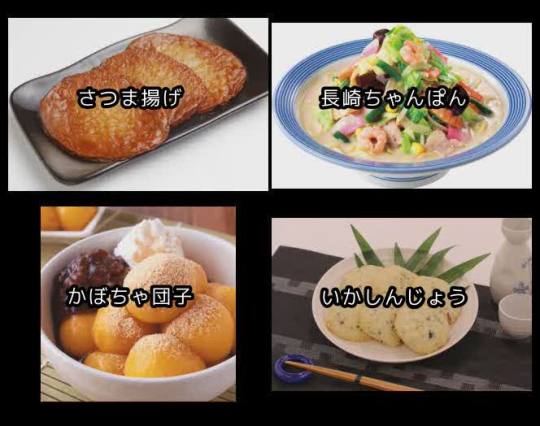
#Fukuoka cuisine#料理トリビア#JapaneseCooking#さつま揚げ#鹿児島の料理#かぼちゃ団子#pumpkin dumplings#Ikashinjo#Kagoshima cuisine#熊本の料理#fish cake#長崎ちゃんぽん#長崎の料理#Nagasaki cuisine#Kumamoto cuisine#Nagasaki Champon
0 notes
Photo

さつま揚げ
鹿児島の料理
さつま揚げは、さつまいもを主な材料とした揚げ物で、九州地方、特に鹿児島県を中心に親しまれる郷土料理です。
1. さつまいもを使用
さつまいもを薄切りにし、油で揚げて作られます。甘くてほくほくしたさつまいもの風味が楽しめます。
2. シンプルな調理
一般的には、さつまいもを薄切りにし、油で揚げるだけで作られます。揚げた後、塩を振って食べることが多いです。
3. 甘さと香ばしさ
さつまいもの自然な甘みと香ばしい風味が特徴で、サクサクした食感が楽しめます。
4. おやつやおかずとして親しまれる
一口サイズにカットされており、おやつやおかずとして一般的に食べられます。
✄🔪🥄🍽✄🔪🥄🍽✄🔪🥄🍽✄🔪🥄🍽
fish cake
Kagoshima cuisine
Satsuma-age is a deep-fried dish that uses sweet potatoes as its main ingredient, and is a local dish that is popular in the Kyushu region, especially Kagoshima Prefecture.
1. Use sweet potatoes
It is made by thinly slicing sweet potatoes and frying them in oil. You can enjoy the sweet and fluffy sweet potato flavor.
2. Simple cooking
Generally, it is made by simply slicing sweet potatoes and frying them in oil. After frying, it is often eaten with salt sprinkled on it.
3. Sweetness and aroma
Sweet potatoes are characterized by their natural sweetness and aromatic flavor, and you can enjoy their crispy texture.
4. Popular as a snack or side dish
It is cut into bite-sized pieces and is commonly eaten as a snack or side dish.
0 notes
Text
DISCOVER THE CULINARY WONDERS OF KYUSHU WITH JNTO’S ALL-EXPENSES-PAID JOURNEY

View On WordPress
#authentic cuisine#breathtaking landscapes#culinary tour#cultural experiences#Fukuoka#japan#JNTO#Kagoshima#Kitakyushu#Kumamoto#Kyushu#Singapore#sponsored trip#travel opportunity
0 notes
Photo

A true #Kaiseki #Omakase & #Whisky Appreciation Dinner with a top Kaiseki chef who hails from #Sapporo #Hokkaido #Japan and superbly paired with top-notch cutting edge whiskies from the Nagano and Kagoshima region consisting of #iwai #mars Manzanilla single malt Komagatake and single malt Tsunuki - astonishingly smooth and awesome! Considered the epitome of Japanese cuisine, Chef Saitoh-san, uses his Kaiseki and Omasake technique to showcase his title as the grand master of Japanese cuisine, and he came to Singapore, out of his own desire, to share the appeals of traditional Japanese cuisine, which is recognized as a UNESCO Intangible Cultural Heritage. Saitoh-san uses his professional experience and discerning eye to procure only the finest ingredients. This ability is vital in Japanese cuisine where much emphasis is placed on seasonality and the ability to bring out the best of every ingredient. Seasonal fruits and vegetables that are usually not easily obtained, as well as fish and meat of the highest quality, are procured from all over Japan. The Tasting Panel were thoroughly spoilt with an 8-course menu which was well curated with the 4 distinct whiskys on-taste at each tier within the degustation. My personal favorites were the sashimi - whiskey aburi snapper, scallop and botan shrimp… temaki hand roll, charcoal grilled kurobuta black pork infused with whiskey… and the chuturo sushi.. i like the way how the appetizer was being assembled in a kaiseki-formatted provision and the motivation behind the chef’s hand whipped matcha.. truly one of the best whiskey pairing dinners I have ever had.. @sushi.sei.sg @rosettemedia @rosett_asia The quality was impeccable, the ingredients super fresh, and sashimi well-structured.. my media rating is at 9/10, much higher than most omakases that i have tasted at well known establishments in Asia, Shanghai, Ho Chi Minh and Singapore. . . #love #instagood #fashion #beautiful #happy #art #photography #style #travel #life #cute #hiso #luxury #lifestyle #SGLifestyle #like4like #photooftheday #picoftheday #instamood #ooishi (at Holiday Inn Singapore Orchard City Centre) https://www.instagram.com/p/CpCaIIju92m/?igshid=NGJjMDIxMWI=
#kaiseki#omakase#whisky#sapporo#hokkaido#japan#iwai#mars#love#instagood#fashion#beautiful#happy#art#photography#style#travel#life#cute#hiso#luxury#lifestyle#sglifestyle#like4like#photooftheday#picoftheday#instamood#ooishi
3 notes
·
View notes
Text
Japan Series Kagoshima / Eat Drink and Be Merry
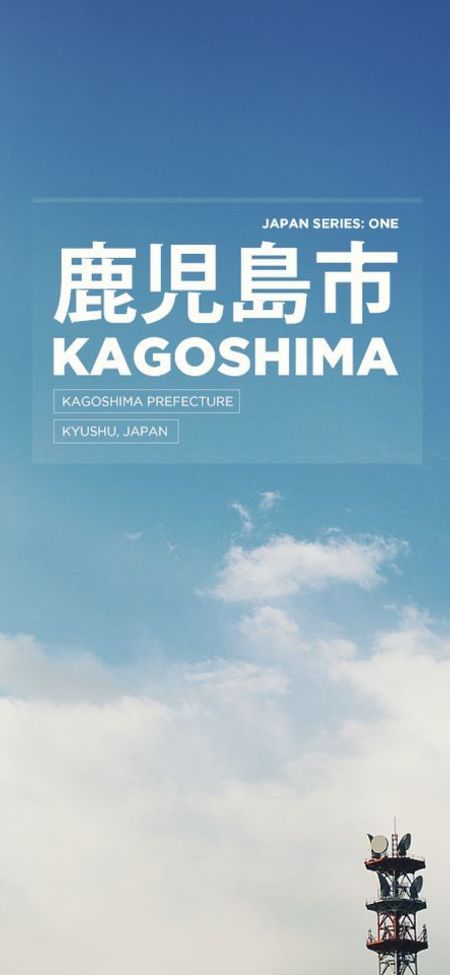
Exploring the enchanting city of Kagoshima in our Japan Series. Discover hidden gems and indulge in authentic Japanese cuisine.
0 notes
Photo
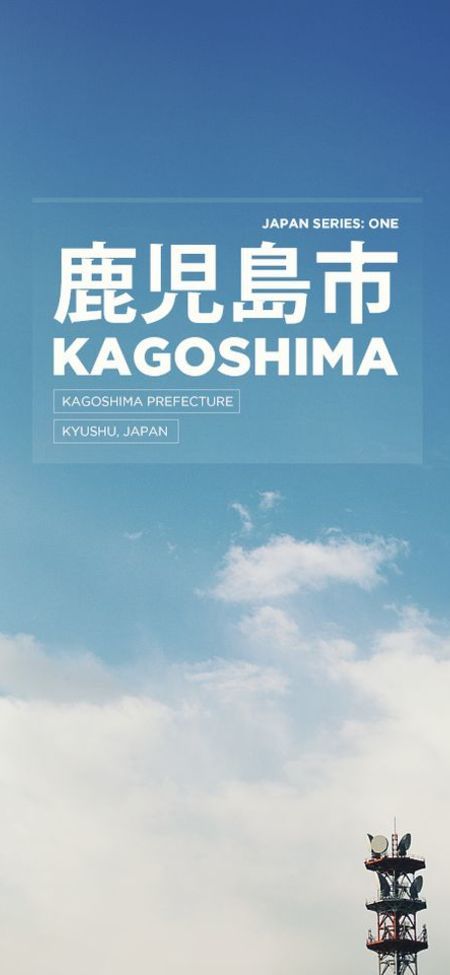
Japan Series Kagoshima / Eat Drink and Be Merry
Cheers to a delicious journey through Kagoshima. Savoring the vibrant flavors of Japanese cuisine and embracing the art of indulgence.
0 notes
Photo
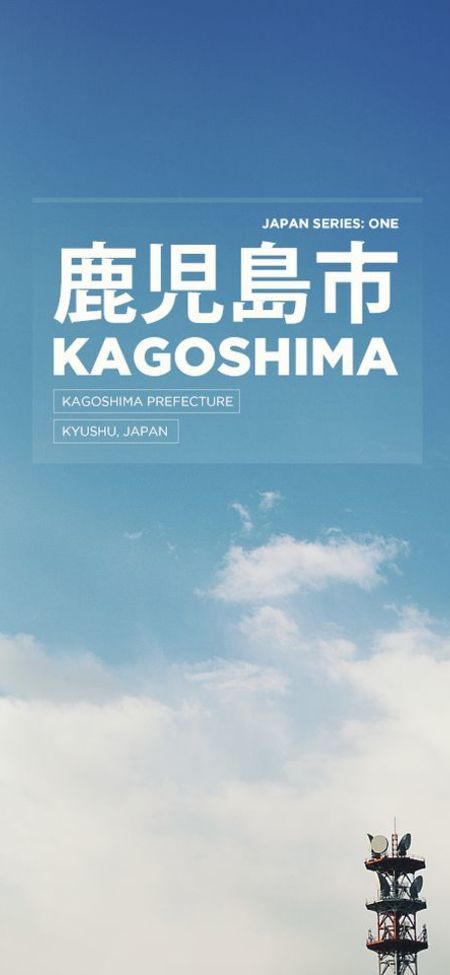
Japan Series Kagoshima / Eat Drink and Be Merry
Cheers to a delicious journey through Kagoshima. Savoring the vibrant flavors of Japanese cuisine and embracing the art of indulgence.
0 notes
Text
🌟 Embark on an Epic Journey through Japan's Hidden Treasures! 🌟
Welcome to a remarkable expedition that unveils the secrets of Japan's lesser-known wonders. Beyond the bustling cities and iconic landmarks lies a world of enchantment waiting to be discovered.
🎌 Introduction to "Japan's Hidden Treasures" Dive into our captivating journey through the Land of the Rising Sun. While Japan's famous destinations are renowned worldwide, there's an entire realm of hidden treasures that often remain undiscovered. Join us as we peel back the layers of mystery and explore the lesser-trodden paths of this remarkable country.
🎑 Itinerary 1: Exploring Tottori's Mystical Landscapes Step into the mystical realm of Tottori, where captivating landscapes await. From the breathtaking Tottori Sand Dunes to the serene Uradome Coast, this 7-day journey promises adventure and tranquility.
🏖️ Sneak Peek: Ever dreamed of sandboarding down colossal dunes or riding camels along the coast? Tottori offers these surreal experiences and more. Read more about it here
🍜 Itinerary 2: Aomori Prefecture: Nature's Tranquil Haven Aomori Prefecture beckons with its natural beauty and tranquility. From the historic sites of Aomori City to the scenic wonders of Towada-Hachimantai National Park, this 7-day adventure promises a deep connection with nature.
🌸 Sneak Peek: Explore the historic Hirosaki Castle, take a ferry to Sakurajima's active volcano, and savor shabu-shabu or tonkatsu - just a taste of what Aomori has to offer. Read more about it here
🌿 Itinerary 3: Exploring Yakushima's Natural Wonders Delve into the heart of Yakushima, Kagoshima Prefecture's natural paradise. A 5-day journey takes you through ancient forests, Jomon Sugi hikes, and cultural insights that reveal the island's unique ecosystem.
🌳 Sneak Peek: Towering Yakusugi cedar trees, challenging hikes to Jomon Sugi, and a deep dive into Yakushima's culture await. Read more about it here
🍣 Itinerary 4: Culinary Adventures in Lesser-Known Japan For the foodies, we've curated two delectable destinations: Kochi and Kagoshima. Taste your way through local cuisines, from seared bonito in Kochi to Kagoshima's famed kurobuta pork.
🍱 Sneak Peek: Dive into traditional cooking classes, savor regional delicacies, and witness local craftsmanship. Read more about it here
🏞️ Itinerary 5: Immersive Experiences in Rural Communities In this segment, explore Ojika Island, Shimane Peninsula, and Tsuwano. Immerse yourself in the warm embrace of rural communities, uncovering their unique traditions and serene beauty.
🌅 Sneak Peek: Island welcomes, hidden coves, samurai districts, and a steam train adventure - just a glimpse of the immersive experiences that await. Read more about it here
Join us on this captivating journey and experience Japan in a whole new light. Discover the enchanting stories and hidden treasures that make this nation truly extraordinary.
🗺️ Get Ready for Your Adventure: Read More
Get ready to be enchanted by the lesser-known wonders of Japan - it's a voyage of a lifetime! 🇯🇵
1 note
·
View note
Photo
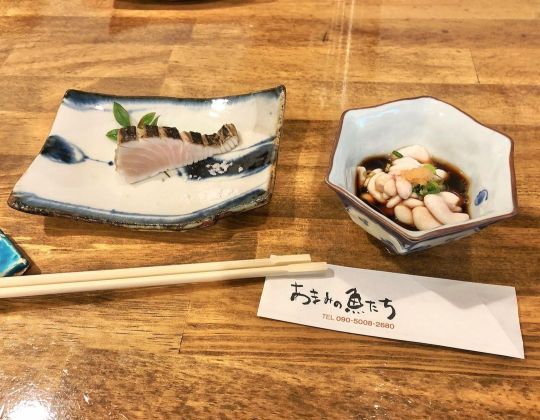
#throwback to an amazing meal via an Amami fish specialist at @amaminosakana A beautiful mix of seafood from Amami and beyond consisting of: Amami bonito tataki with Amami sea salt w/ shirako (sperm sacs of male cod) Amami Japanese Bluefish dumplings Super juicy Ikura salmon roe from Hokkaido Skrimpzzz A lovely assortment of Amami squid, octopus, and lightly-charred Deepwater Longtail Red Snapper. Sauced Yakougai Great Green Turban shellfish w/ garlic bread And a huge plate of bonito and (tuna?) sashimi at the end Oh mama mia, the perfect meal to set the tone for DJing at the Amamism show at Asivi the next night. The wonder and magic of Amami Oshima is always blowing my mind. #奄美 #奄美大島 #奄美グルメ #島 #魚 #鹿児島 #鹿児島グルメ #名瀬 #amami #amamioshima #island #islandlife #japan #japanesefood #food #fish #local #kagoshima #kagofan #dondonkagoshima #bonito #cuisine #delicious #foodstagram #sakanatachi #shellfish #ikura #shirako #japanese (at 奄美大島) https://www.instagram.com/p/CoqhFbpy5tq/?igshid=NGJjMDIxMWI=
#throwback#奄美#奄美大島#奄美グルメ#島#魚#鹿児島#鹿児島グルメ#名瀬#amami#amamioshima#island#islandlife#japan#japanesefood#food#fish#local#kagoshima#kagofan#dondonkagoshima#bonito#cuisine#delicious#foodstagram#sakanatachi#shellfish#ikura#shirako#japanese
0 notes
Text
Most Beautiful Summer Destinations In Japan
Summer holidays in Japan are truly one of a kind. Escape the hustle and bustle of your city life and immerse yourself in scenic surroundings and cultural boost at some of the hill regions. It is going to be a truly magical summer of your lifetime.
Warm weather immediately calls for a mountain retreat in Japan. If you are confused about the plenty of summer getaways in Japan, then here we are.
The post presents the most scenic destinations to have the time of your life in Japan.
Yurikehama: If you have been searching for the most scenic summers in Japan, you can try visiting the Yurikehama beach on Yoronjima Island.
What’s unique about this beach is that it only appears one hour before low tide. It is a pure white sandy beach to spend some time, relax and unwind with your dear ones.
Yurikehama is on the east coast of Yoronjima Island where you can reach via plane either from Kagoshima or Okinawa.
Ishigaki Island: If you are really hoping to see clear ocean floors this summer, you can plan a trip to Okinawa.Kabira Bay has a stunning place called Ishigaki Island, where you can ride on a glass bottom boat to admire the beauty around you.
The island is mere 40 minute drive away from Ishigaki city.
Hokkaido:Nothing feels more exciting than going to high altitude during summer. You can explore Orofure pass this summer to explore majestic views.
Situated at more than 900 meters of altitude, this place is on the bucket list of those who wish to look at a sea of clouds. Both sunrise and nights are magical at this destination.
Gunma:For a dose of lush greens and serene water, you can choose Gunma prefecture. Here you can explore the Asian Niagra Falls at Fukiwari Valley. Hiking around the waterfall is truly a blissful experience during summer.
The waterfall is only 40 minute drive away from KannnetsudouNumata IC.
Nozawa:Although the breath-taking ski resorts make it a stunning winter destination, Nozawa onsen village is truly the perfect choice for summer vacations as well. You find plenty of exciting opportunities to enjoy the green season in this scenic village.
The mountain trails, fresh food at Nozawa Onsen Restaurants and plenty of fairs and festivals make your summer even more exciting.
Take a Nozawa Onsen Liner bus and roam around the town for a memorable summer experience. Besides, the season is apt for multiple adventurous activities like biking, hiking, trekking, and water rafting, and some calming experience like music camps and Yoga and meditation retreats.
Conclusion
Island country Japan has plenty to offer all year round. Both summers and winters can be truly mesmerizing. If you are planning to explore the scenic landscape and a dose of unique Japanese culture, then you must not miss the festivals and local cuisine at Nozawa.
For booking and reservations, contact Stay Nozawa. They are backed with local knowledge and years of experience to help you find the best Nozawa Onsen accommodation ski-in ski-outresorts along with transfers, lessons, lift passes and gear rentals. You can even get their help to find the best locations and accommodations during summer.
0 notes
Photo
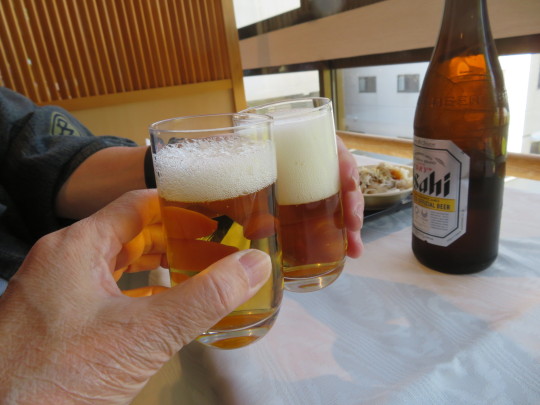
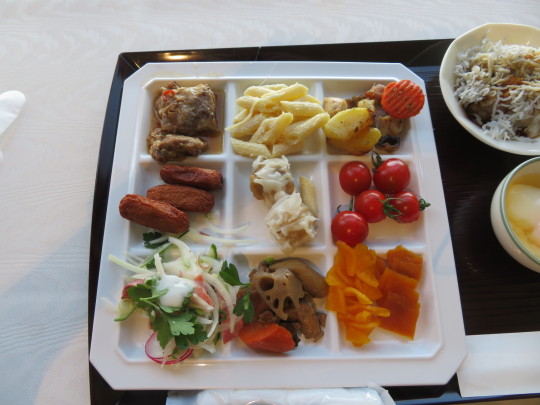
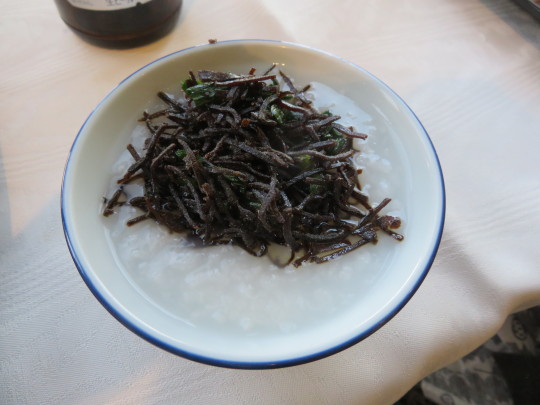
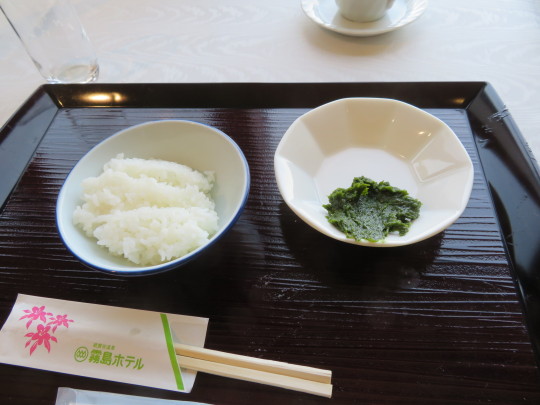


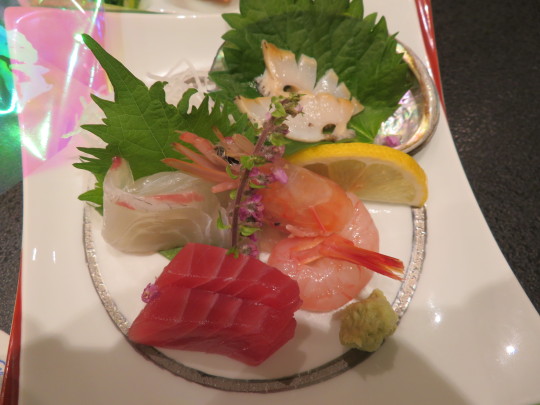
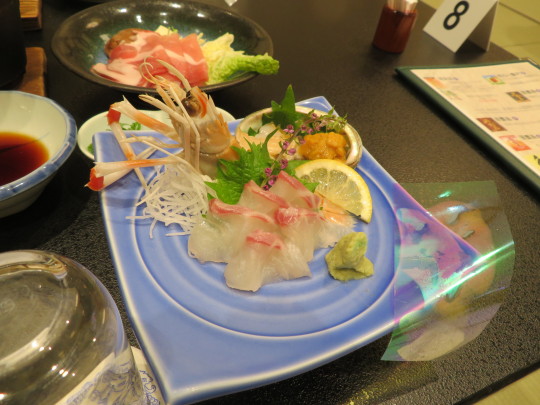
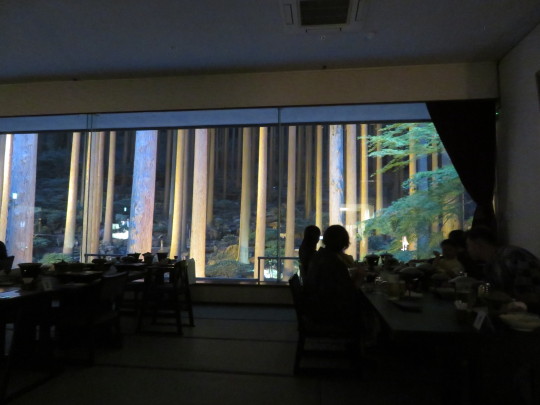
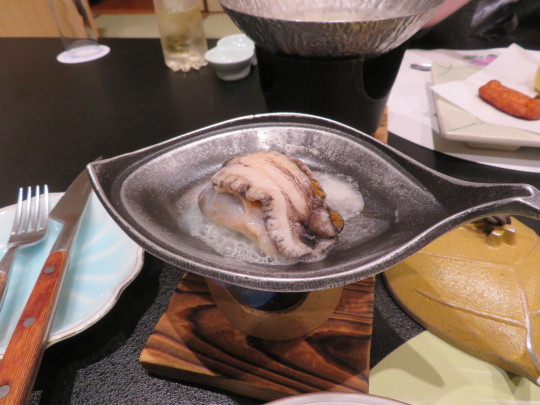
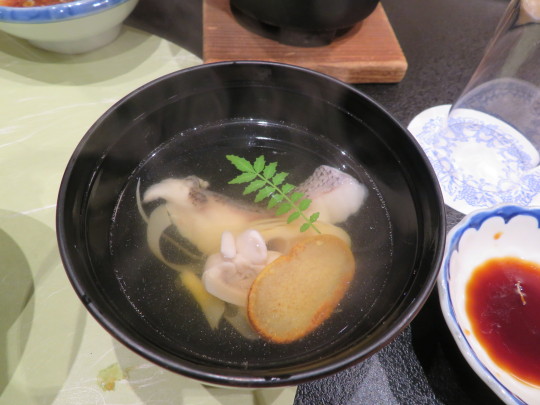
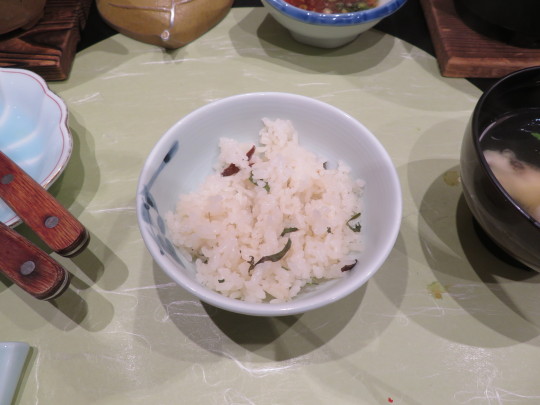
Breakfast and dinner at the Kirishima hotel.
64 notes
·
View notes
Text
Nikkei, Kagoshima Wagyu & Sake Dinner
Nikkei, Kagoshima Wagyu & Sake Dinner

Nikkei Rockwell takes Kagoshima’s top-grade Wagyu to even grater heights through a Wagyu and Sake dinner only for one night. Last October 03, renowned guest chef Samata serves up six delicious courses paired with top-shelf sakes selected by Premium Wine Exchange.
(more…)
View On WordPress
#Filipino Food Blog#Filipino Food Blogger#Japanese Cuisine#Japanese Food#Kagoshima Wagyu#Makati#Nikkei#Nikkei Cuisine#Philippines#Rockwell#Sake#the hungry chef#thehungrychef#Wagyu
0 notes
Photo
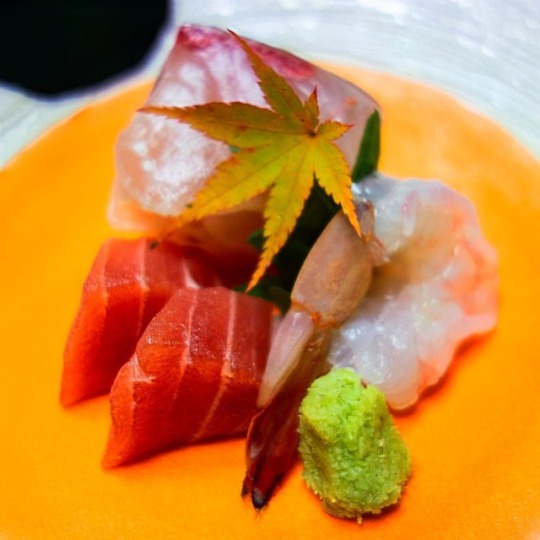
We stayed at "Hotel Kayoutei" this day. The price is high hotel. There was a feeling of cleanliness in the room and the food was delicious, but it was not a fee corresponding to that. It was a hotel which think that education of staff is important. 宿泊は新川渓谷温泉郷・天降川温泉ホテル華耀亭へ。結構いいお値段の宿なので期待して訪問したのですが、入ってから早々ガッカリさせられる。部屋は清潔感があり料理も美味しく頂けたのですが、スタッフの教育というのが重要である事がよく分かるものでした。温泉がいいだけに残念な宿。 #kagoshima #kirishima #hotsprings #kirishimaonsen #hotel #kayoutei #onsen #amorigawa #photo #shorttrip #cuisine #japanesefood #鹿児島県 #鹿児島 #霧島 #霧島温泉 #天降川 #天降川温泉 #華耀亭 #温泉 #鹿児島旅行 #旅 #旅行 #和食 #露天風呂 #写真 (霧島温泉郷 ホテル華耀亭) https://www.instagram.com/p/BsnTzdBgX46/?utm_source=ig_tumblr_share&igshid=1osbhrir0jkpx
#kagoshima#kirishima#hotsprings#kirishimaonsen#hotel#kayoutei#onsen#amorigawa#photo#shorttrip#cuisine#japanesefood#鹿児島県#鹿児島#霧島#霧島温泉#天降川#天降川温泉#華耀亭#温泉#鹿児島旅行#旅#旅行#和食#露天風呂#写真
0 notes
Photo
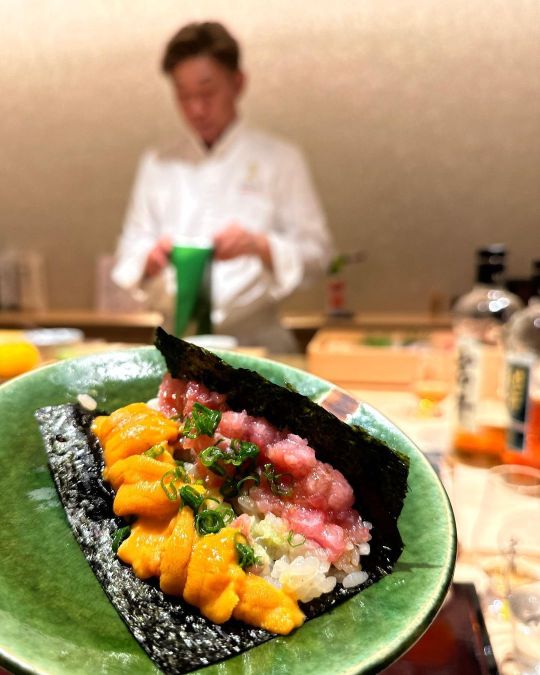
A true #Kaiseki #Omakase & #Whisky Appreciation Dinner with a top Kaiseki chef who hails from #Sapporo #Hokkaido #Japan and superbly paired with top-notch cutting edge whiskies from the Nagano and Kagoshima region consisting of #iwai #mars Manzanilla single malt Komagatake and single malt Tsunuki - astonishingly smooth and awesome! Considered the epitome of Japanese cuisine, Kaiseki renders and preserves tradition and culture and in this regard, Chef Saitoh-san, uses his Kaiseki and Omakase based-techniques to showcase his title as the grand master of Japanese cuisine, and he came to Singapore, out of his own desire, to share the appeals of this traditional Japanese cuisine, which is recognized as a UNESCO Intangible Cultural Heritage. Saitoh-san uses his professional experience and discerning eye to procure only the finest ingredients. This ability is vital in Japanese cuisine where much emphasis is placed on seasonality and the ability to bring out the best of every ingredient. Seasonal fruits and vegetables that are usually not easily obtained, as well as fish and meat of the highest quality, are procured from all over Japan. The Tasting Panel were thoroughly spoilt with an 8-course menu which was well curated with the 4 distinct whiskys en-taste at each course tier within the degustation. My personal favorites were the sashimi - whiskey aburi snapper, scallop and botan shrimp… temaki hand roll, charcoal grilled kurobuta black pork infused with whiskey… and the chuturo sushi.. i like the way how the appetizer was being assembled in a kaiseki-formatted provision and the motivation behind the chef’s hand whipped matcha.. truly one of the best whiskey pairing dinners I have ever had.. @sushi.sei.sg @rosettemedia @rosett_asia The quality was impeccable, the ingredients super fresh, and sashimi firm and shiny.. my media rating is at 9/10, much higher than most kaiseki and Omakase that i have tasted at well known establishments across Asia. . . #love #instagood #fashion #beautiful #happy #art #photography #style #travel #life #cute #hiso #luxury #lifestyle #SGLifestyle #like4like #photooftheday #picoftheday #instamood #ooishi (at Holiday Inn Singapore Orchard City Centre) https://www.instagram.com/p/CpCaIIju92m/?igshid=NGJjMDIxMWI=
#kaiseki#omakase#whisky#sapporo#hokkaido#japan#iwai#mars#love#instagood#fashion#beautiful#happy#art#photography#style#travel#life#cute#hiso#luxury#lifestyle#sglifestyle#like4like#photooftheday#picoftheday#instamood#ooishi
1 note
·
View note
Text
Koito Otonoshin is from Kagoshima; what does the city and area reveal about his character.
While on holiday, I was very lucky to have a chance to visit Koito’s very own hometown of Kagoshima, in Kagoshima Prefecture on the southwestern part of Kyushu. I’ve grown more attached to Koito’s character as the manga has developed and I’m more curious to try to figure out what he will do in the manga now that he has been “reunited” with Tsurumi. So, I figured why not go visit his hometown in January when the weather will be lovely [it was]. I will admit that I tricked my Mom to go with me not knowing it was a Koito research trip, but at least told my brother. He was fine with it since he had wanted to visit the nearby Miyazaki prefecture anyways.
This will be a little bit of a different meta post as I’ll present things I observed and try to place Koito in the context of them. This is based on my opinion and how I interpreted and observed things around me. Please keep that in mind when reading!

To get to Kagoshima, I took full advantage of the JR Rail pass for tourists and left from Kyoto to Kagoshima-chuo, the main train station with a transfer at Shin-Kobe. I went down in early January and it was lovely to see the scenery become more green as I went further south. Kyushu has a different feel than the island of Honshu, you see subtropical and tropical plants and it really feels different than other parts of Japan that I have visited e.g. Tokyo, Kyoto and Osaka. This was my first time visiting Kyushu and I really loved the southern part of the island.
If you are using a rail pass to get there, it will take you some time, it was about 5 hours or so in total from Kyoto. If you go from Tokyo, it will take at least 7 hours and that is just from Kagoshima-chuo to Shinagawa (Tokyo area) station. If you are unable to use a JR pass, like my brother who is currently working in Japan, or you have very limited time, the best option is to fly, say from Tokyo-Haneda to the Kagoshima airport (40 min bus ride from downtown Kagoshima).

The most obvious thing about Kagoshima and the area, is how different it is than parts of Honshu. The entire area has that tropical/subtropical feel. It was January and the weather was quite pleasant, around 14-16 degrees C as the high during the day and lows around 7 or so. It was sunny and there were flowers blooming everywhere in gardens and parks and you are right next to the bay! It was so lovely.
I have somewhat limited travel experience in Japan only able to previously visit cities like Nagoya (for work), Gifu (for work but Oda Nobunaga!), Kyoto, Nara, Osaka, Hiroshima, Tokyo and Shizuoka (for maguro tuna) before this trip. What I can say from the start is the feel and look of Kagoshima is different than these other cities. There are more colorful buildings in Kagoshima, some were green, lime green, light pink, magenta and orange intermixed with the more standard, black, grey, white of the modern Japanese landscape. The urban landscape was more varied and interesting than other cities I’ve been to in Japan.
There were many older western style buildings and street lights / lamp posts that looked like they were from 1880-1930. For example here is a public building that clearly looks like it is from 1900-1930 or so. I tried to figure out what it was, but it simply said civic building and likely was now associated with the performing arts center right next to it from about the 1950s/1960s. You can see lots of cycads(!) planted out in front of the building.

The city still runs streetcars that have old lamps as a part of the posts that hold up their electrical cables. I forgot to take a picture of some of the streetcars; half of their cars were old, ~1940s-1950s at the newest as well as sleek modern streetcars. I snapped this photo of the streetcar operator while riding in the city. Yes, it is an old lever operated drive system! It appeared to be made by Mitsubishi, and you can see the flowers blooming in the background.

A great example of a more western style building was this large department store in the downtown part of the city. It is the Yamakataya Department store, and after some quick online searching it appears to have been built around 1917 with other parts added on over time. You can find more photos of it on TripAdvisor.
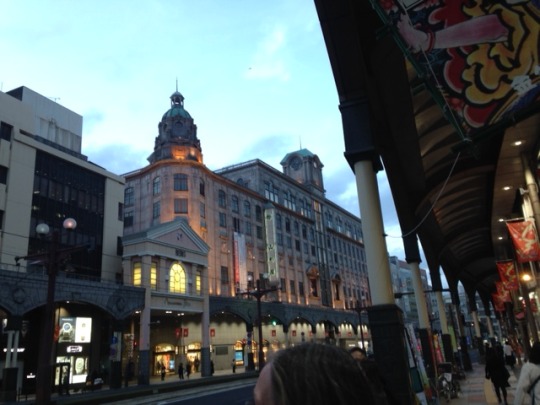
I spotted other older Victorian and turn of the century buildings in the city which added to the unique vibe of the city. While wondering around the local shopping arcades looking for a restaurant, we stumbled upon an interesting glass ceiling at one of the intersection of the arcades. Four locations are shown on the map, Kagoshima, Malacca (Malaysia), Goa (India) and Basque (Spain).
This one shows Kagoshima and Malacca, with ships, churches and random people meeting missionaries, specifically Jesuit missionaries including Francis Xavier, who visited and converted people to Christianity in Kagoshima in 1550.
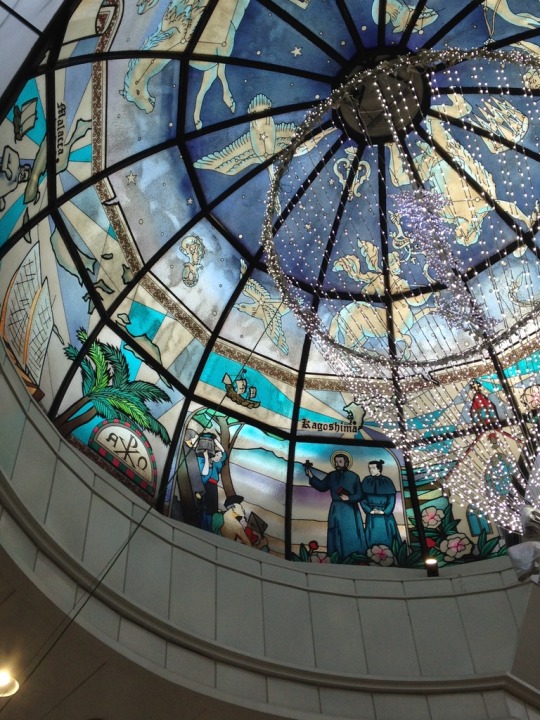
The Basque region of Spain, where Francis Xavier is originally from, though he worked throughout Asia. He was a pretty successful missionary all things considered.

It highlights his time as a missionary in Goa, India
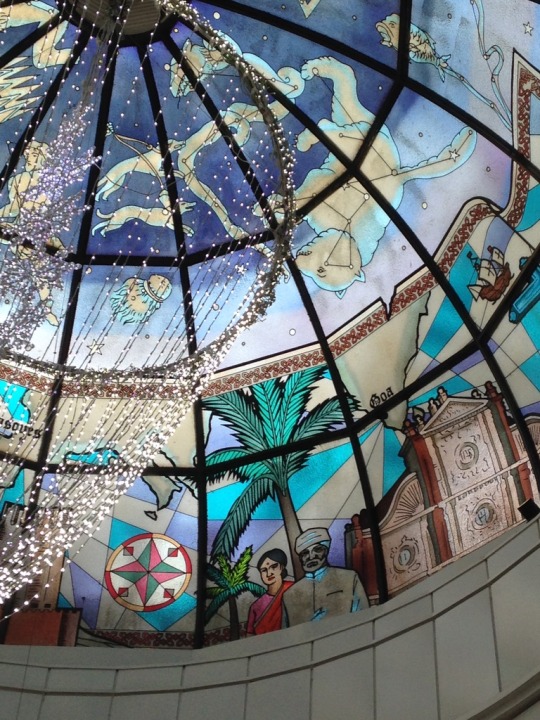
And of course in Kyushu, including Nagasaki and other places as well as Kagoshima. I find it quite curious they have the classic Greek constellations on the sky and not the Japanese ones. It is quite clear that the Jesuit missionaries had an important influence on many people in Kyushu and they still have the highest number of Christians in Japan. I would guess that local people commissioned this artwork since it clearly celebrates the life of Francis Xavier and connects Kagoshima to the other places he lived and worked.
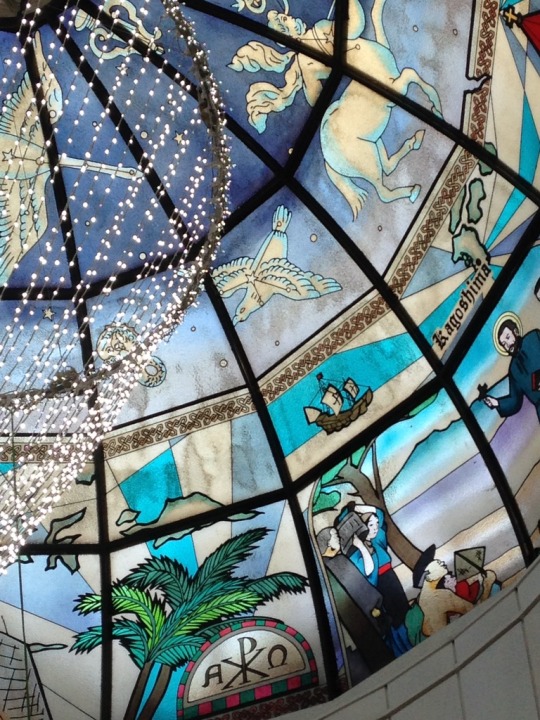
Kagoshima is uniquely situated as how far south it is from both Kyoto and Tokyo [Edo]. By road it is between 800-900 km to Kyoto and 1,300-1,400 km from Tokyo. This implies that it would take a long time before modern technologies in transportation to go between the places of power pre-Edo period and during the Edo period.
I was able to visit Sengan-en an estate of the Shimazu family. The Shimazu family held power in the region since around 1300 and were both powerful warlords, but also successful in international trade due to their location on Kinko Bay. As the Shimazu family were still under the power of the Tokugawa shogunate they were required to journey to Edo, but as a result of the distance, they had the longest overall travel time out of everyone in Japan. I’m sure you can quickly realize that having such a distance from the central government also resulted in the Satsuma domain having more freedom than say a powerful samurai family in Shizuoka.
Even when the Tokugawa shogunate closed off most of the country, this region was still able to trade internationally by proxy through the Ryukyu Islands (Okinawa) and developed more international style cuisine as a result. Sweet potatoes were introduced via Okinawa and the Satsuma sweet potatoes are everywhere. I bought and tried some dried-ish sweet potatoes that looked like twizzlers, but were underwhelming (I think this was a tourist trap, oh look sweet potato things, I’ll try them!). At Sengan-en, we ate some of the baked sweet potatoes of the local variety which were incredibly delicious as just plain potatoes. I’ve had baked sweet potatoes elsewhere in Japan and outside, but this was the best plain baked sweet potato I have every had! I also got sweet potato candy which is delicious, a variant of the famous Bontan Ame (a citrus caramel candy), also invented in Kagoshima! Bontan Ame is also a great candy, I love the subtle citrus flavor.
The sweet potato are the purple caramels on the right and the citrus Bontan Ame on the left. quantivore’s Koito is excited with Tsukishima in between! (quantivore’s artwork can be found on instagram @quantivore ).

Bontan Ame are popular with high school girls . . . for some odd reason I think that Koito would like them too!
I was able to sample some local Kagoshima shouchu, which again, is not surprisingly made from their famous Satsuma sweet potatoes! It tasted good and was pretty strong. I may have had more to drink than I should have with my yakiniku. There were soooo many varieties of shouchu to choose from in the area and they were sold at pretty much every gift shop! I did not buy a bottle since I was afraid to haul it all around Japan and break it on accident.

Recall that the manga highlighted that the Sakurajima daikon are cultivated in the area around the Sakurajima volcano and are the largest daikon in the world as introduced in chapter 197.
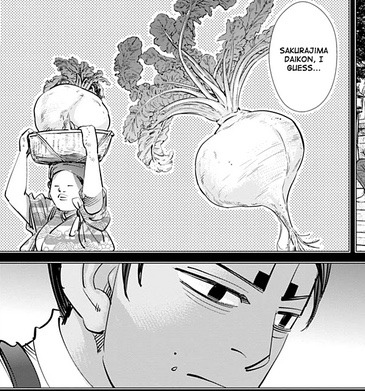
I was unable to see a full daikon in the flesh, while visiting the Sakurajima Geo-Park, I did spot some growing in the ground and you could see large leaves! I really wanted to see a Sakurajima daikon, in person. The daikon was found on public city artwork and designs. I had to settle with only seeing their leafy tops while on a bus, though I bought a small daikon charm and my brother found me a plushie at the airport. I did eat some daikon (already cut to a much smaller size) with the regional black pork which was delicious. The pork was richer than normal ground pork and the daikon melted in your mouth as you ate it cutting through the richness of the pork.
The daikon is important to Koito’s flashback as it helps to introduce his contrast to his older brother, who had a pale complexion like a Sakurajima daikon and tolerated Koito calling him that.
The last major regional produce of the area is citrus! There is so much citrus in the area! The Satsuma oranges (as they are known in the UK) came from the Kagoshima region after they went to war with the British in 1863! As a result of a naval battle between the Shimazu family and their fellow Satsuma retainers, this war only lasted a few days and resulted in great damage to the Kagoshima area. The positive outcome of this was increased positive relations between the Satsuma region and the UK as opposed to the influence the French government had on the dying/declining Tokugawa shogunate in Edo.
Here is a Satsuma orange tree at Sengan-en. It had an info plaque about how after the Anglo-Satsuma war they were popular for import to England.
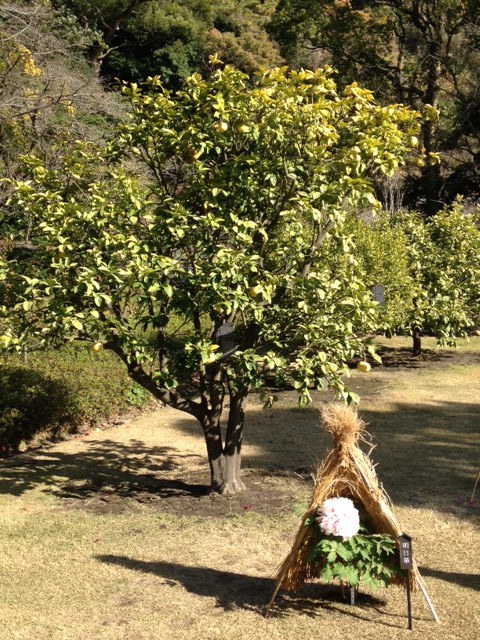
In addition to the Satsuma oranges (aka mikan), there is a distinct variety from the area known as komikan or small mikan. These are grown both on the volcano, Sakurajima (桜島小みかん) and around the Kinko Bay as well (小みかん).
Look at the tiny tiny tiny komikan!
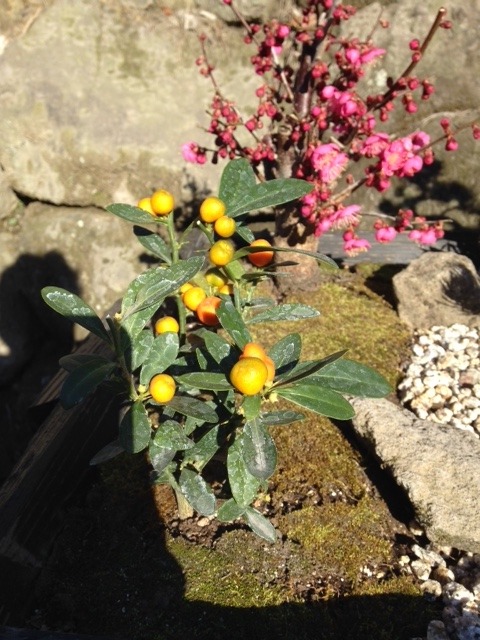
The regular mikan were quite easy to peel and delicious. Throughout the southern part of Kyushu there were lots of different citrus species and cultivars grown. In the neighboring Miyazaki prefecture, they had a yuzu x pomelo hybrid known as a hyuganatsu (also tasty in things!). I digress, the point is Kagoshima as the former Satsuma domain is a place that was able to interact with western nations and it is in part represented by the movement of the citrus fruits from the area to places like the UK and the USA as well where the States actually imported and grew cultivars from the Kagoshima area.
This region was also much more forward thinking that the government in Edo. The Shimazu family were the second largest book publishers in Japan for a very long time and they reprinted Western imported books that included science, technology and maps. I was able to see some of their moveable type for their publishing with both Japanese kanji and kana and the Latin alphabet as well for printing foreign books (I did not spot any Cyrillic, but the museum display was small).
They were the birth of industrial manufacturing in Japan, first trying to build equipment via imported books and later sent students abroad against the rule of the government to study in the UK and the USA. At the grounds of Sengan-en you can visit the first factory in Japan which gives a quick guide in Japanese and English about the development of industrial manufacturing. Unfortunately, you were unable to take pictures in the museum, but they produced various goods including cannons and whatnot which helped in late Bakumatsu period and gave them a weapons advantage over the outdated technology of the Shogunate government forces.
When you get off the train at the main Kagoshima-chuo station and walk towards the bus and streetcar stops, there is a statue erected in honor of all of the young students who risked going abroad to help the growth and development of Kagoshima.
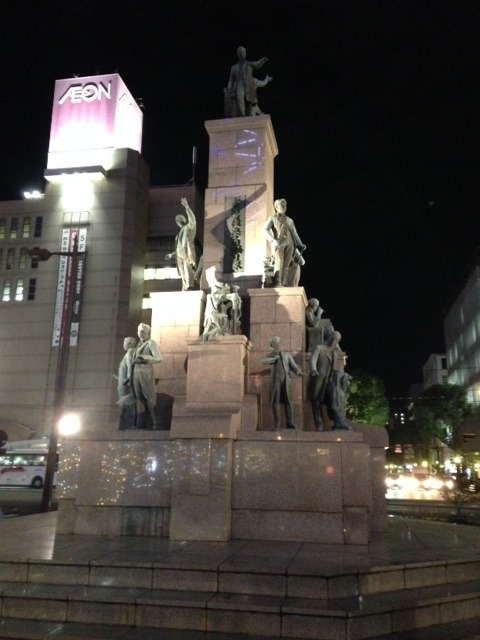
These students also attended a World Fair in Paris or some of them not quite sure if all of them attended it was after their trips abroad. They also circumvented the travel restriction for Japanese by registering not as from Japan but representing the Satsuma domain as an independent delegation. I may not be 100% accurate with all of this info, since I couldn’t take photos in the museums, yet it gives you a good idea of what the Satsuma domain was doing to improve and modernize.
There is also a strong connection between Satsuma and Hokkaido - many of the leaders during the Meiji era that pushed industrialization were from Satsuma and used Hokkaido as the source for raw materials to power the factories in the south. Plus, many people from the region moved to Hokkaido to work either as the frontier soldiers or as laborers in the “frontier”. This has been mentioned before in regards to GK as Noda’s own great-grandfather was a frontier soldier from Kyushu (whom I’ve wondered was also a practicing Catholic based on how Noda depicts Christian theology). I recall reading this in some interviews with him translated by GK Central, but I forget which ones right now.
Another industry that grew up in the mid 1800s was the development of Satsuma cut glass (kiriko) which become more industrialized during the late Edo early Meiji period. Unfortunately, the technology was lost and in the 1980s, it was finally determined how to manufacture it again. As a result production started again and it is only produced in Kagoshima.
On the grounds of Sengan-en they have a fully operational glass works. You can watch the glass being blown, shaped, cooled, marked and cut. It was pretty neat! I thought about buying some; it was more expensive than I expected - small pieces started at about $200 USD and it only went up from there. There were gorgeous sets of two glass that sold for about $500 and it was clear they were wedding presents. It was really amazing and if I had more money, I’d be tempted to purchase some myself. My Mom did purchase a small green and blue bowl after looking at it at the glass works, and then looking at it in a Satsuma local goods store two more times before deciding to actually purchase it.
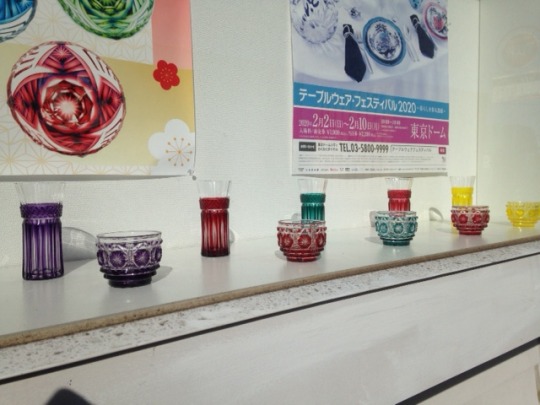
Since it was unique, the distribution of this from Satsuma helped with international relations and was considered neat by those in Europe who could purchase it. I think the best way to look at the cut glass is that it was an excellent example of a Satsuma [Japanese] product that combined with a European product, illustrating how this region was changing to adapt to modern times outside of Japan. There was also Satsuma porcelain that was made for the European market and it was very successful around the time of Golden Kamuy as an export.
To get an idea of the type of house that Koito likely grew up in, it would be something similar to, but obviously smaller than a place like Sengan-en. The house was quite large and the gardens and other buildings around it made for a place that was large and significant looking. It also had a mix of a Japanese and more Western style for some of the buildings as well as Chinese and Ryukyu influence.
This is the main gate that leads into the area where the house is in a large courtyard. It has a much more Chinese style with the bright red and slightly different roof shape. The English info said it was Chinese style, but I wonder if it wasn’t more Ryukyu since they were the domain that was essentially “controlling” *ahem* them at the time.

This was the inner courtyard of the house. The house had been added onto over time from the 19th into the 20th century as well as some parts being removed like household secretary rooms and other stuff now outdated.
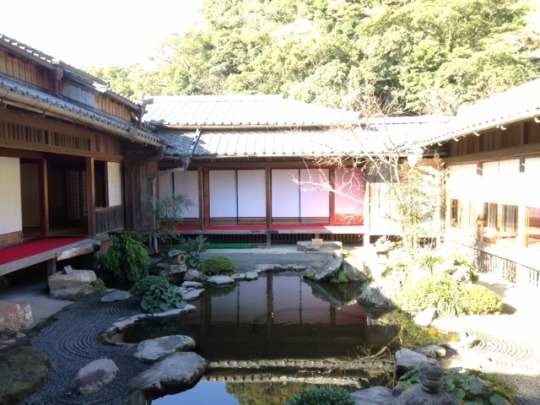
The Shimazu family often hosted foreign dignitaries including Tsar Nicholas II (obviously before the Russo-Japanese war)!!! There were two large vases that were gifted to the family from Nicholas II on display in one of the rooms with lots of historical information about how the family hosted many people from around the world. Many of the people hosted here were from the UK and the Netherlands as well. If I recall correctly, the highest number of foreigners were from the UK (again, that Sastuma orange link).
This is an example of how the table would have been set for dinners for hosting European guests. The vast majority of the house was still completely Japanese in style in regards to the furniture, but this dining room and another (sitting? living) room had Western style furniture. The table setting appears to have Dutch plates, Western cutlery and several types of glasses including the local Satsuma cut glass produced in the local glass works. I believe my Dutch Canadian friend has the exact same plates that you can still buy today.

I took tons of photos of the grounds which featured many tropical and subtropical plants like these cycads and palm tree. You can see some of the buildings in the background and a Western style lamp post as well.

I have no idea what this building originally was, but it was clearly based on a European inspired design and a part of the estate. It is now a Starbucks and I didn’t investigate it any further.

The style of this house makes me think of the house that Koito lived in when his family moved from Kagoshima to Hakodate. There was also a “foreign engineer” house close by where English engineers lived and helped with the development of Kagoshima. I was a moron and forgot to visit it . . . but I did see it from the road.
https://whc.unesco.org/en/documents/136169
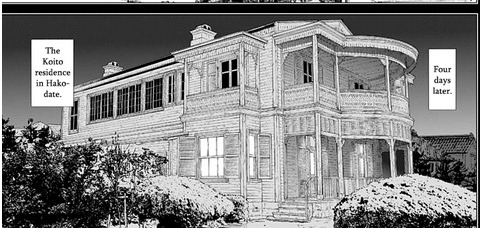
I would say it is a toss up if Koito lived in a modern Japanese style house/estate like Sengan-en in Kagoshima or in a more modern house like the white one on the Sengan-en estate or the “Hakodate” house above.
What you get from visiting a place like Sengan-en is what it would have been like to be an elite from the former Satsuma Domain/Kagoshima. Including your personal doctor inspecting your poo everyday . . . These [predominately] men in power were hosting and having dinners with foreigners and were very passionate about the modernization of Japan in the face of the world colonial powers getting closer to them.
This connects with the fact that Koito owns the motorbike. Now it is unclear if this came from a Japanese individual in France or directly from a French person. When I did my chapter meta, I assumed it came directly from a French person but upon reading it again, the translation is unclear what the nationality of the acquaintance is, just a person in France not actually French. What it does show is that Koito’s father is connected internationally as a member of the Meiji elite many of whom came from Satsuma due to their pro-Western technology slant so that the could expel the barbarians [and freely make use of their science and technology for Japan]. I would guess the fact that Koito Sr. served the Meiji government well, indicated he was more in favor of modernization and less about a more hyper samurai opinion to maintain the old ways during modernization (e.g. Saigo Takamori).
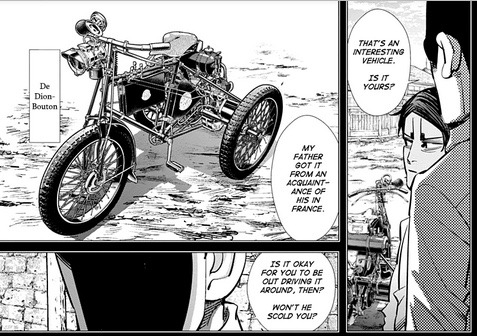
Another thing is how the men in power from places like Satsuma linked themselves to the former shogunate through marriage and likely married women from the “losing” side to further integrate themselves into the power base in Tokyo. You wouldn’t want to completely cut out the losing side completely. Instead, with those that likely switched sides sooner integrate with them as you had the “in” to the old government which would become key for the new government fit into for stability. Completely cutting off members of the former government would lead to future issues since many of those individuals were still clearly wealthy and had more local connections in Tokyo than someone from Kyushu may have had.
Recall, when Hijikata fights Inodou, he mentions Enomoto Takeaki in chapter 135 as noted by EHS scans. He was a member of the Shogunate government who was key in founding the Imperial Navy that Koito’s father is a member of.
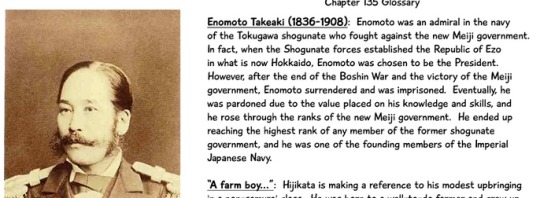
Another thing I learned at Sengan-en is that one of the Shimazu daughters married the last shogun in part to politically sway the shogun to transition and make way for the new Meiji government. This again shows that those from places in the south were positioning individuals to allow them to create a new government as easily as possible.
Since Koito’s father is a tall, darker complexion Satsuma man, as Koito is, his flashback highlights how different his mother looks. She’s very light in complexion and Koito mentions on his older brother looked like a Sakurajima daikon with very light skin tone.
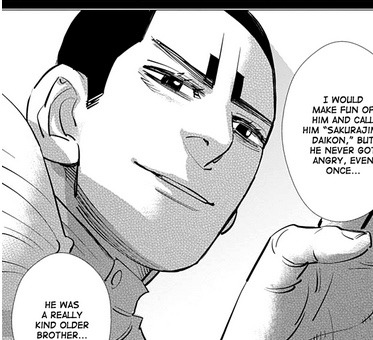
Koito and his brother got their eye brows from their mother, yet he did not get her lighter skin tone, so on top of his Satsuma accent, other characters can tell that he’s from Kagoshima (or at least someplace in Kyushu).

I find it interesting that Koito’s mother is wearing a kimono in a house that is completely Western in decor and she almost looks uncomfortable in her surroundings. I can’t help but think it would be more socially appropriate for Koito’s mother Yuki, to also adopt Western style dress to fit with her position and role as the wife of an important member of the military and modern society. It is clear they are hosting foreigners in some fashion. When I was visiting Sengan-en, there were many photos of women wearing Western style dress ~1900, so many of them also adopted their fashion like their male family and friends did. Yet, instead, she seems out of place as though she didn’t grow up with this style (somewhere around Tokyo perhaps) and is unsure how to fit within it. Koito in contrast since his introduction at 14, is shown wearing full Western style dress and he’s sporting a much more Western style hairstyle than any other character had as a kid. Does he have an English style haircut?
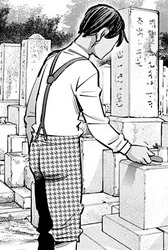
I always get the feeling that Koito being raised in a more Western learning environment as a child in Kagoshima and being surrounded by a greater mix of people and seeing more differences he is just more comfortable in his role as a future military kid. He may not even realize it, but compared to many of the other GK cast members he’s both sheltered and open to things with his education. He has been spoiled and it shows in his dependence on Tsukishima, yet at the same time, he’s one of the most educated members of the group and has to be multilingual.
His bratty behavior which does not result in punishment from his father is also interesting as I sometimes wonder if his father was hoping he’d out grow things or come to his senses. It sounds like a more Western way to parent, but it is still the early 1900s so I could totally be off the mark here. Plus, in Koito’s flashback he seems to imply his brother’s death resulted in his father detaching himself from Koito, perhaps out of fear that if he did what his older brother did, he too would die? I think this makes sense with how Koito Sr. does rescue him and also when he tells Koito he’s glad he’s alright post-Karafuto-Sugimoto stabbing.
Some more general observations from walking around Kagoshima. People there seemed more relaxed, I observed people jaywalking, crossing a street against a “no crossing” sign and cars honking at each other! The feel is completely different than very stoic cities like Tokyo or Kyoto. Not surprisingly, there were also people with complexions that were darker like Koito and his father as well in Kagoshima and Miyazaki prefectures, so he really is a character based in reality. Not that I doubted Noda, but he really does try to make his characters as realistic as possible. I’m sure with current beauty standards people are more aware of this and try not to tan as much as they would have in the past, but there were quite a few people who just had a different skin tone and it was January, so not a lot of long days of sunlight.
The other aspect of Kagoshima is its relationship with the volcano, Sakurajima. The daikon and komikan are both grown on the slopes of the volcano due to the soil and are important local products. The volcano dominates the region as it is visible from pretty much anywhere in the city. It is also a very active volcano, with ash coming out almost continuously and with multiple eruptions per day. When you walk around the city there is ash everywhere on the ground, under bushes and in corners. The city has active street cleaners/sweepers to remove the ash from the roads.
Here is my first good view of the volcano taken around 5pm from the Dolphin Port area. You can see a little bit of the ash coming out of the right side of the southern peak.

Here is a view of Sakurajima from Sengan-en. The ash is mixed with the light clouds but again it is moving to the left (a southern direction). If you look closely you can see the electric rail line above the wall for the JR Kyushu local lines.

This is the best scenic shot taken from Shiroyama, a view point in a public park again around 5pm. Unfortunately, the trees and bushes obscured part of my view to include the northern part of Kinko Bay (to the left). Yes, that is ash from the volcano drifting off to the right.
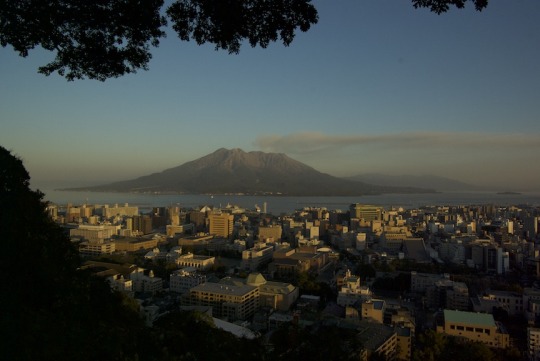
A similar shot from the manga is here in chapter 197.
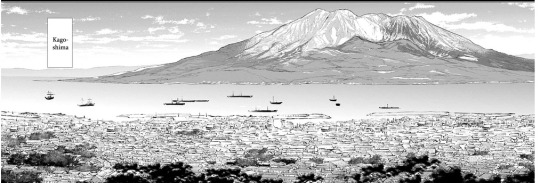
Here is a bit more zoomed in photo showing how the city is right across from the volcano.
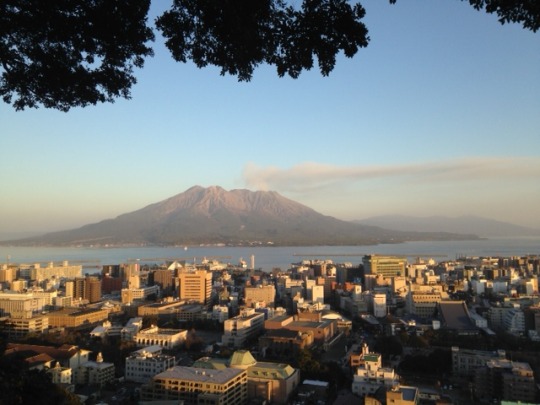
I was able to take the ferry across to the volcano a quick 15 minute ride. The volcano was a separate island until an eruption in 1914. Hence the name of Sakurajima even though it really isn’t an island (-jima) anymore. Interestingly, during Koito’s time (pre-1914), the volcano was dormant for most of the previous century but since they were growing the crops that thrived on the volcanic soil they were more than aware of the power of the volcano.
Here is a picture of one of the four ferries in action. These had space for regular passengers as well as cars for the lower decks.
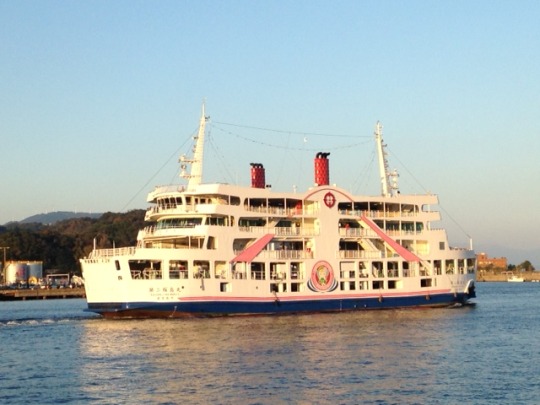
The entire bay and surrounding area are a large caldera. I’m failing to explain this well, but the volcano really is a major presence in the area. Kind of like how you feel when you see Mt. Fuji, Niagara Falls, the Grand Canyon etc but more personal. This is from the lookout point on Sakurajima. The volcano rises up in the background.

From the viewpoint you can look back across the bay towards Kagoshima. It was cloudy and overcast the day I visited the volcano; this is looking towards where Sengan-en is.
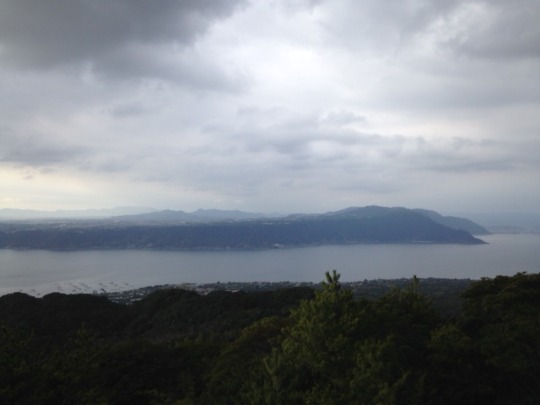
This is looking south towards the base of the bay eventually leading toward the ocean (it curves towards the left for the ocean).
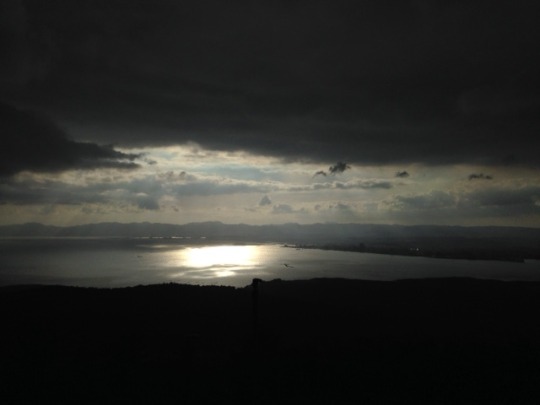
As we took the ferry back to Kagoshima port, the sunset highlighted the cloud and ash covered top of Sakurajima.
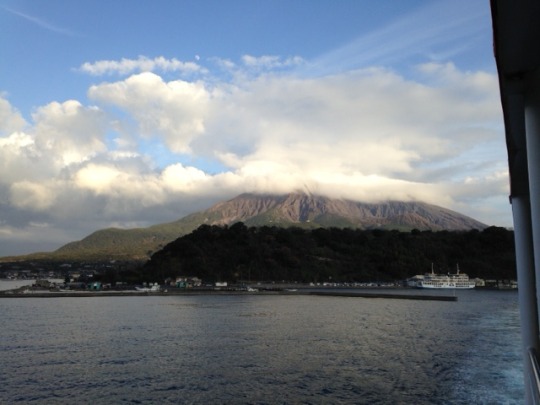
What I’m really trying to highlight is how Sakurajima is a fundamental part of the Kagoshima area (it is part of the city) and it has influenced this area for a long time.
Unrelated, there are lots of stray cats on Sakurajima that are friendly and like to be petted. About 50% of the population all have these stubby tails as I got this shot of an orange and black cat with the volcano in the background. I did pet this cat. My brother also petted some of the cats too.

With all of the things that I learned in my visit to Kagoshima, I will use them to try to understand parts of Koito’s character and what may happen in the future for his character.
1.) Koito as a Satsuma elite -
It became very clear to me visiting museums and walking around the city that Kagoshima is a very European influenced city and prized including a Western education. My Mom also remarked that it appeared much more diverse in architecture and more Western looking (and she had no idea that I was observing this for my meta).
It is no surprise that Koito would have been a well educated young man and also interacting with foreign visitors on a regular basis. Before his older brother died he sounds like he was energetic but likely much more well behaved than his 14-16 year old self. Once he realized he wanted to go into the Army after his “rescue” by Tsurumi, he was an excellent student and excelled at his courses and passed his exams to enter the military college.
He trained in Jigen-ryu and based on his skill he has shown so far in his fight with Sugimoto on the airship and when he attacked the random Russian prisoner. Even if he was a wild child, he must have kept up the practice as demonstrated when he encounters Tsurumi in Kagoshima. He states that he’s the son of an important man, so he’s of course using that to his advantage and he’s upset. (special thanks to @goldenkamuyhunting for letting me use the new volume 20 pages!).
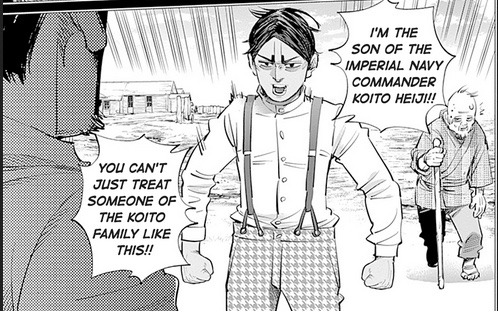
He then challenges Tsurumi with the old man’s cane instead of a sword. Sure he loses for all sorts of reasons - using what appears to be a lightweight cane, letting himself get overly emotional . . . the fact it is Tsurumi.
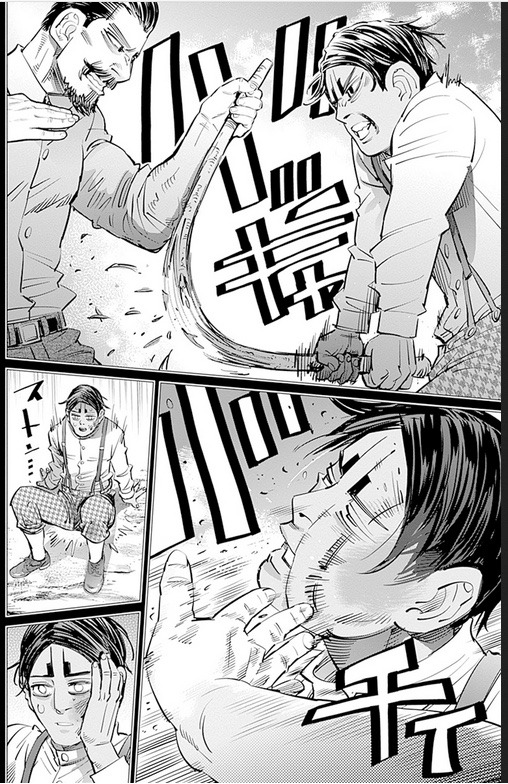
But after Tsurumi slaps him and leaves him in shock both failing to defeat him and using jigen-ryu, Tsurumi flatters him on his form. I take this to imply even if he is rebelling, skipping school and whatnot, he’s still practicing his jigen-ryu.
Previously, many of us avid readers of the series wanted Sofia and Koito to meet in Karafuto as we wondered if he was fluent in French as required for a military officer. However, after leaning that many people from Satsuma were aligned with the UK and also interacted with the USA around this time, I’m wondering if Koito can speak English instead. Tsurumi purchased weapons from a foreign arms dealer, Mr. Thomas (chapter 31). It is pretty damn obvious with the name of Thomas this man is an Anglophone. Though he’s based on a Scottish man, so he’d have a unique accent.
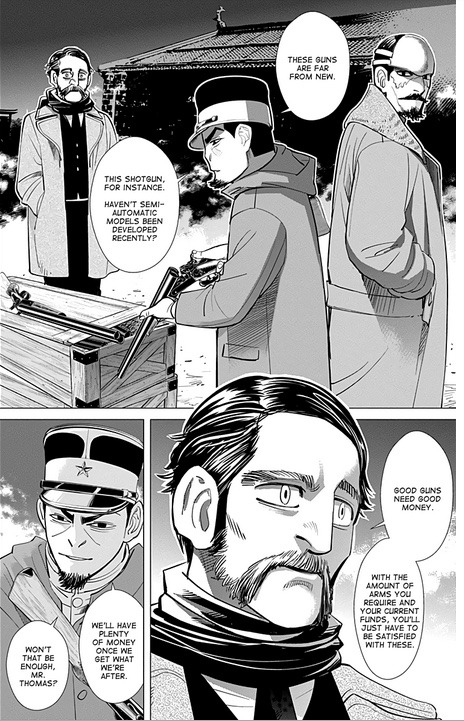
It is clear in this chapter that only Tsurumi and Tsukishima are meeting with Mr. Thomas in an isolated location. Based on the fact that Tsukishima and Tsurumi are both speaking with him, I would assume that they are speaking Japanese. This does not rule out that they also corresponded with him in English as well. I wonder if Mr. Thomas will reappear in the manga again as an arms dealer. Will the Anglo-Japanese relations of that time period come into play?
@goldenkamuyhunting has previous written about the fact that Mr. Thomas is likely based on Thomas Blake Glover a very successful merchant and business man in Japan who started out in Nagasaki. He also was one of the allies of the Satsuma domain families and involved in sending the students abroad to the UK.
Since Glover was more than willing to work with those in the Satsuma and Choshu domains, eventually leading to the overthrow of the shogunate government, perhaps we are to read that he’d be okay with another rebel faction in Hokkaido? Or since he became successful through relations in Kyushu does Koito Sr. know him?
2.) Koito is a citrus fruit.
This is a bit of an unusual angle, but I’m going to follow Noda’s lead here. Koito refers to his older brother as a Sakurajima daikon. It is clear that was his teasing nickname for his older brother, but it also something that he associates with his brother as a way to remember him now that he is gone.
If Koito Heinojyou is a large white daikon, than there are two options for Koito Otonoshin; sweet potato or mikan/satsuma orange. Sweet potatoes are more of a commoner food (alternative to rice) so a mikan makes more sense. I’m sure rich people still ate fancy sweet potato things, but likely in 1900 not all commoners could eat all the citrus grown in the area. Fresh fruit is always expensive.
Citrus fruits are brightly colored and energetic. All of the ones in Kyushu are various shades of orange and yellow. The mikans are a rich orange and are sweet and tangy. The aren’t a root vegetable like daikon or sweet potatoes, they grown on trees. Citrus need lots of care and attention to thrive. Citrus can only grow in warm climates and until modern industrial agriculture are in coastal regions (we are not discussing the central valley in California for various reasons). They also have fragrant flowers and are associated with people who are fresh, exciting, colorful and energetic. When you eat any type of citrus; lemon, lime, grapefruit, pomelo, yuzu, mandarin, mikan, clementine . . . etc no one would describe the flavor as weak, dull, or subtle. They are sweet, tangy, sour, bitter and aromatic as well. There is a lot of emotion and depth in citrus.
He’s charming and canonically an attractive male character. Sei Kobiyama has tweeted about this when the Vol 16 cover came out and the red eyeliner is linked to him be an attractive young man.


He’s got upper class manners and enjoys his Russian tea time.
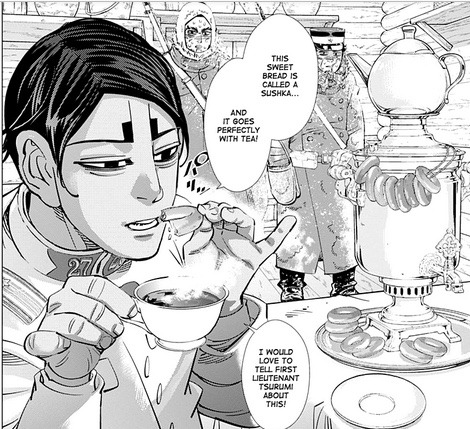
Sei Kobiyama also noted that even when he tries to be angry and mean he doesn’t swear like the rest of the cast.

His deadpan upon his realization that he set Sugimoto up with his sabre blade.

The look of absolute horror that he may rip his skin off when trying to remove the cold hammer. I feel sorry with the volume edit where it is clear Sugimoto chased after him and pissed on him . . . why didn’t anyone suggest pouring some hot tea on his hand?
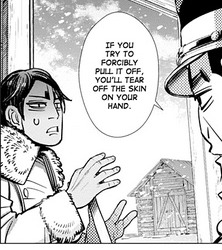
All of these aspects of citrus apply to Koito. His brother was a solid first son, well behaved and stable just like the large Sakurajima daikon. He is a native of the area, but his mother’s background is reflected in him as well. When Koito is rescued by his father and Tsurumi, we learn that Koito Heiji is also a much more dramatic and energetic man rushing in to save his son. These are passionate men who when at their best radiate this energy and warmth.
Koito’s older brother is a boring old root vegetable while he and his father are clearly sassy citrus, needing their sunshine and pruning etc etc. They may be capable men but face it, Koito Sr. spent too much time hiding his feelings and Koito is a very pampered guy who is very concerned about his appearance. Sure, he wanted Tsukishima to get his hand mirror so they could locate Vasily . . . but . . .

. . . but not without fixing his hair before looking!
And one of my absolute favorite jokes in the entire manga. Yes, I think Noda watched the classic comedy/parody “Spaceballs” for inspiration as a Princess has a ton of luggage that she insists on taking with her to the annoyance of commoners who rescued her.
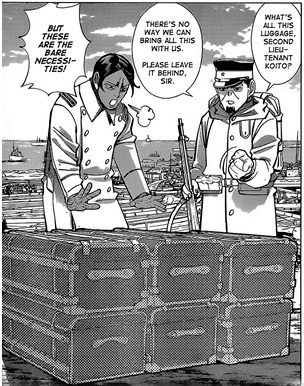
I predict 50% of this contains personal care products for him. He’s so far north he’ll need to moisturize, and his hairstyle likely requires all sorts of products to keep it in such tip top condition. Okay, I’m jesting a bit, but I’m sure a lot of his stuff is for him to pamper himself.
Maybe as things change he’ll become a sweet potato? His hair color is pretty much the same color as one of the local Satsuma varieties - I kind of want to send Noda a message if Koito’s hair color is sweet potato colored. According to Sei Kobiyama he’s supposed have crow feather colored hair, which is considered very beautiful, but I see sweet potato.
3.) Koito comes from a region where people have recently questioned authority.
The most famous individual who helped shape Meiji era Japan and was from Kagoshima was Saigo Takamori. Tsurumi (as Hasegawa) tells Wilk, Kiro and Sofia about the 3 main founders of modern Japan. Sofia was compared to Saigo and he is from Kagoshima. Despite the fact that he lead to the change in government, he found himself in disagreement with the Meiji government and eventually returned to Kyushu to lead dissatisfied samurai of the region in a rebellion against the government.

It was clear visiting Kagoshima that he’s still a very famous and respected man, with many of the sites that you can visit are related to him. There is a statue of him along the art & culture road and he’s found everywhere; in shops, on o-miyage, products. If you see his statue in Tokyo’s Ueno Park, he’s portrayed in a less positive fashion (he’s got a bit of a beer gut as we’d say in English).
What is interesting is that Saigo worked in the Meiji government for some time. He didn’t just immediately fight against those he should be serving. Instead, he worked as a part of the government for some time and his somewhat both logical yet flawed ideas attempted to deal with the rapid social and societal change that the Meiji government was forcing upon everyone. He however, seemed more focused on the military than industrializing which would be counter to what he would have ultimately wanted. I’d say the soft power of the Shimazu family was much more forward thinking as they wanted to pursue industrialization.
Koito has spent a long time of his “focused” life trying to serve Tsurumi and prove to his father that he will be a good soldier. With the flashback in chapters 197-200, and his confrontation with Tsukishima in 210, he almost had a nervous breakdown.

He started to put things together and when Tsukishima threatened him and told him how Ogata killed Hanazawa he just was in complete shock. He was screaming in a non-Satsuma accent as he just did his best to behave how Tsukishima would anticipate he would behave.
I think in part when he got stabbed by Sugimoto when Asirpa escapes is in part due to the fact that he was still in shock. He lacked the usual energy and passion and overall “Koito-ness” that he’s shown in many other chase scenes. I honestly felt Koito was going through the motions when pursuing Asirpa and Sugimoto. Based on his mistake of approaching Sugimoto, I really think this adds to how he wasn’t quite with it during that chapter. He didn’t know what to think or do so he just went with the flow and relied on his training to cover up the fact that he clearly was a mess inside learning about Tsurumi. Even though he’s quite passionate and emotional at times he clearly does hold some of his emotions in and indicated by his distance/sulking post Ogata escape.
He stubbornly tries to get Tsukishima to keep pursuing Sugimoto as he weakly tries to waive him off. He’s trying his best to be a tough Satsuma Hayato (which I think is what he thinks he should be doing/acting as), and he made a mistake fighting Sugimoto even though he did the best he could do. He’s likely feeling very ashamed and still trying to determine what is going on with Tsurumi anyways. I also agree with Sei Kobiyama here that even though he’s a Satsuma Hayato, he’s too “nice” to really be one. I just keep coming back to him and Enonoka.

When we finally learn about his health he tells his father that he’s pitiful. Is he pitiful since he tried to stop Sugimoto? That he realized he’s been used by Tsurumi since he was 14? That Ogata gave him enough information that he sees what Tsurumi is doing isn’t for the benefit of the military and instead it is for Tsurumi’s own personal goals? The good thing about Koito being injured is it will give him a lot of time to think and rest. I really think him cornering Asirpa less than 12 hours after he learned part of the truth from Tsukishima was not a good thing for him.
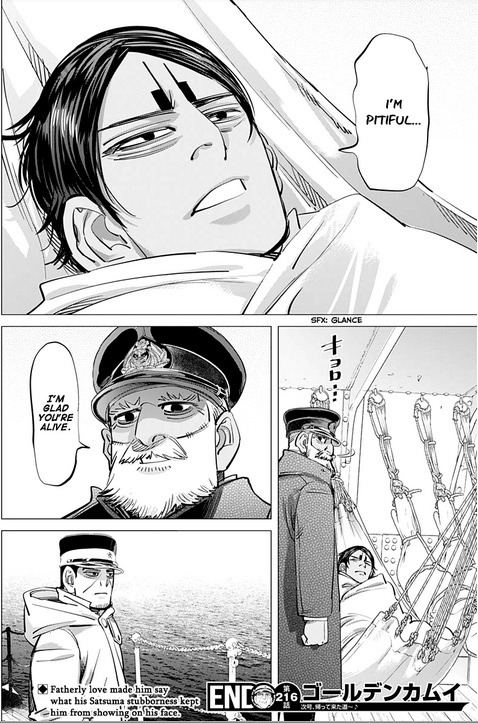
That pained look on his face as his father looks away before telling him that he’s glad that he’s okay . . . and thankfully when Inkarmat finally reappears, she’s giving him his daily fortune as well as Tsukishima. His blush likely indicates he’s got some sort of crush on Inkarmat. He’s an extroverted guy, so he’d likely get along with someone like her. Even though he doesn’t interact with many females, I get the feeling that he relates to them better than men. I just think of how he was so sweet and respectful of Enonoka and he clearly enjoys Inkarmat’s company. I get the feeling that Inkarmat in canon is supposed to be a very attractive woman and we know she is both charismatic and independent.

Koito has kept himself going by trying to follow the military order and establishment up to this point. For him to question the system and go against Tsurumi, he will have to shatter his entire view of the military and how it operates.
I think Koito will want to seek out the truth as to what is really happening with Tsurumi. We know when he focuses on something he’s successful - just dealing with Tsurumi is going to be very difficult for him.
Thanks to @goldenkamuyhunting, I was able to see this change to volume 20 chapter 200. Koito is able to help himself up by himself from the blows that Ogata dealt to him. Battered and bruised he is able to exit the small hospital and we see a determined yet rough looking Koito. He gives the feeling of a man who wanted to catch Ogata to ask him more. I think Koito is thinking “What do you mean about the Manchuria Railway Ogata? What happened to Hanazawa? Why do you know the word a Russian kidnapper told me?” . . .

We later learn in chapter 210 that Ogata mentioned the Mantetsu (Manchuria Railway) so that Koito would link Hanazawa’s death to Tsurumi’s plans. I think Koito wanted to know what Ogata was referring to. He’s also likely had to rethink his opinion of Ogata based on chapters 200 and 210. He is an officer in the military, he’s an educated elite and he’s putting together big picture concepts that Ogata is dropping him hints about. I think he’s got the potential to be a clever character as well if he can gain confidence in himself. In the revised flashback with Tsurumi when he was 14, he was confidence using his father’s name. He needs to be 100% confident in himself. I hope he can get there!
Really the biggest determent to Koito’s character is how his bratty rich kid attitude prevents him from connecting with others. Time and time again he is not nice to others since he can get away with it. This is the aspect of Koito’s personality that I like the least. The only time that I liked it, is the fact that he is the only character to call out Sugimoto’s bullying and to go head to head with him. I think the rest of the characters may want to stand up to Sugimoto, but they can’t since they aren’t as privileged so they don’t know if they can. Koito however, just uses his baseline sense that he can push back at Sugimoto since “How dare he?” treat him poorly. His reasoning is a bit flawed but his response is what I would like to see others do as well. He really is just like Ogata in that regard, both of them have personalities that developed as a result of their background that makes it hard for others to connect with them. Ogata since he’s so distant refusing to connect with others and being too sarcastic for a lowly superior private and Koito since he’s just used to others obeying him as a result of his family and privilege.
So to stick with the local food analogy - I want Koito to go from being a citrus fruit to a sweet potato. Still important but much more humble.
Another Kagoshima analogy would be that Koito is like Sakurajima. His true potential and skills are dormant, but like the volcano does in his future, 1914, he reaches his full potential and is an amazing leader and force within the country.
Well that is all for my Kagoshima-Koito post. I hope you’ve enjoyed it. I felt that visiting Koito’s hometown gave me a better perspective on him and where he came from. This is something I wouldn’t have know if I hadn’t visited it! I had a great time visiting and learning about Koito, so if you have a chance to visit do so! If people are more interested, I could do a more detailed Koito tourism post in the future.
#golden kamuy#golden kamuy meta#koito otonoshin#koito heiji#koito yuki#koito heinojou#kagoshima#satsuma#satsuma hayato#sakurajima#tsurumi tokushirou#tsukishima hajime
39 notes
·
View notes
